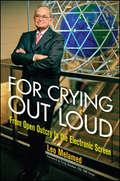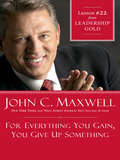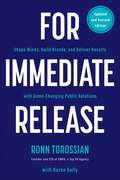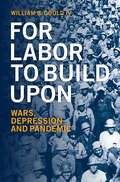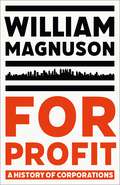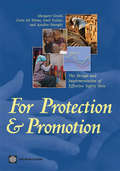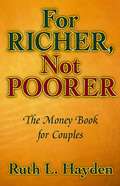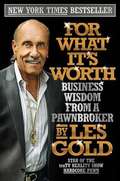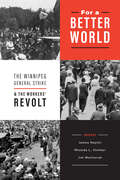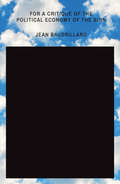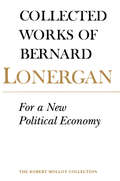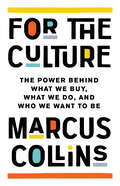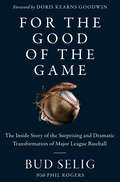- Table View
- List View
For Crying Out Loud
by Leo Melamed Craig DonohueA follow-up to Leo Melamed on the Markets, this book covers the developments in the futures markets since 1992 and discusses their transition through the digital age. The author, a recognized founder of financial futures, details the global issues confronting the futures market. You'll learn how financial markets have allowed investors to manage generalized risks to both reduce exposure or enhance value to capture increased profits. Additionally, you'll discover trends, technology, and products that have shaped the world of futures and options, and what the future holds.
For Everything You Gain, You Give Up Something
by John MaxwellSmart leaders learn from their own mistakes. Smarter ones learn from others' mistakes--and successes. John C. Maxwell wants to help you become the smartest leader you can be by sharing Chapter 22, For Everything You Gain, You Give Up Something, of Leadership Gold with you. After nearly forty years of leading, Maxwell has mined the gold so you don't have to. Each chapter contains detailed application exercises and a "Mentoring Moment" for leaders who desire to mentor others using the book. Gaining leadership insight is a lot like mining for gold. You don't set out to look for the dirt. You look for the nuggets. You'll find them here.
For Free Trade (Winston S. Churchill Early Speeches)
by Winston S. ChurchillThis collection of speeches in support of free trade by the future Prime Minister tracks his early rise in British Parliament. Throughout his career—as both a Conservative and a Liberal—Winston Churchill was a strong supporter of free trade. As a Conservative, this position was sometimes controversial; early in his career, Churchill opposed Joseph Chamberlain's strategy of imposing tariffs to protect Britain&’s economic dominance. When he defected to the Liberal Party in 1904, Churchill continued to be a fierce free trade advocate. Originally published in 1906, For Free Trade was an influential political pamphlet that made Churchill&’s speeches on the subject available to the British people. This collection contains speeches delivered in Manchester or The House of Commons between 1902 and 1905.
For God, Country, and Coca-Cola
by Mark PendergrastFor God, Country and Coca-Cola is the unauthorized history of the great American soft drink and the company that makes it. From its origins as a patent medicine in Reconstruction Atlanta through its rise as the dominant consumer beverage of the American century, the story of Coke is as unique, tasty, and effervescent as the drink itself. With vivid portraits of the entrepreneurs who founded the company -- and of the colorful cast of hustlers, swindlers, ad men, and con men who have made Coca-Cola the most recognized trademark in the world -- this is business history at its best: in fact, "The Real Thing."
For Good and Evil: The Impact of Taxes on the Course of Civilization
by Charles AdamsA fascinating history... —Kirkus Reviews ...an acidly witty guide. —Wall Street Journal
For Good and Evil: The Impact of Taxes on the Course of Civilization (2nd edition)
by Charles AdamsThe very word "taxes" sends shivers up spines. Yet very few realize the tremendous impact that taxation has had on civilization. Charles Adams changes that in this newly revised and enlarged edition of his fascinating history. Taxation, says Adams, has been a catalyst of history, a powerful influence on and sometimes the direct cause of many of the famous events that have marched across the world's stage as empires collided and battled for the right to tax the loser. For Good and Evil is the first book to examine how taxation has been a key factor in world events. Like the Rosetta Stone--itself a tax document--the book sheds fresh light onto much of history. Did you know that biblical Israel split after Solomon's death because his son refused to cut taxes? That Rome rose to greatness because of a liberal tax regime but declined under corrupt and inefficient ones? That in Britain Lady Godiva made her famous ride as a tax protest? That in Switzerland William Tell was made to shoot the apple off his son's head as punishment for tax resistance? Or that Fort Sumter, where the first shots of the Civil War were fired, was a Customs House? Combining facts with thought-provoking comment Adams frequently draws parallels between tax events of the past and those of the present. Finding fault with the way Western civilization is taxed, he provides ideas for curing those faults by using the valuable lessons that history has taught. The special value of this refreshing look at history lies in the lessons to be drawn by all taxpayers: "Taxes are the fuel that makes civilization run, but how we tax and spend determines to a large extent whether we are prosperous or poor, free or enslaved, and most importantly, good or evil." Once you read For Good and Evil, you'll never feel the same about taxes.
For Immediate Release: Shape Minds, Build Brands, and Deliver Results with Game-Changing Public Relations
by Ronn TorossianIt is essential that businesses know how to communicate quickly, often preemptively, and effectively to survive—and at a cost that is far lower than comparable marketing and ad campaigns. The first book by the owner of a top 50 PR agency, For Immediate Release, Ronn Torossian reveals how public relations can do just that—while also defining brands; helping companies and individuals court the press or avoid it; growing business without alienating loyal customers; resolving crises quickly; and improving first page results on the most powerful search engine in the world (Google). For Immediate Release will show you how to: Frame the debate and control the conversation Use new and old media in tandem to find your audiences and create highly personal, relevant impressions tailored for them Promote the interests of your brand or business; deter or potentially stop what is not in your interest Build on great press, and avoid or minimize bad press Ensure the first thing people see about your business or brand during an Internet search is exactly what you want them to see Handle a crisis in the most effective and efficient manner See the positive difference effective PR makes through compelling case studies—Louis Vuitton, Fubu, BP, Toyota, Philip Stein, Zappos, and interviews with experts including Dr. Keith Ablow, political strategists Frank Luntz, Roger Stone and Hank Sheinkopf, and many others—and your own business.
For Labor To Build Upon For Labor To Build Upon: Wars, Depression and Pandemic
by William B. Gould IVOne of the enduring legacies of the United States Civil War is that democracy in the workforce is an essential part of societal democracy. But the past century has seen a marked decline in the number of unionized employees, a trend that has increased with the rise of the internet and low-paying, gig-economy jobs that lack union protection. William B. Gould IV takes stock of this history and finds that unions, frequently providing inadequate energy and resources in organizing the unorganized, have a mixed record in dealing with many public-policy issues, particularly involving race. But Gould argues that unions, notwithstanding these failures, are still the best means to protect essential workers in health, groceries, food processing, agriculture, and the meatpacking industry, and that the law, when properly deployed, can be a remedy not only for trade union-employer relationships, but also for the ailments of democracy itself.
For Nature/With Nature: New Sustainable Design Scenarios (Springer Series in Design and Innovation #38)
by Claudio GambardellaThis volume contributes to the construction of a multi-voice mosaic on the theme of Nature and the relationship between Man (understood as designer) and Nature by emphasizing the innovative and sustainable proposals coming from the discipline of design, in its many facets and interdisciplinary contributions. Since it isn’t discussed the creative and economic effort that designers, institutions and companies have been leading for years to improve human living conditions, preference will be given to scientific contributions (unpublished or not yet fully known case studies, projects of strategies, products, systems and services, theoretical contributions, communication) that are an expression of a new approach to Nature, seen as our ally and object of an ethics of care. The focus is the design both in its role as innovation driver and interpreter of social evolution, that must be considered within the human-nature relationship. The topics identify some of the most relevant fields of development in which "Design Driven Innovation" can be developed in the respect of perspective of a new relationship with nature.
For Profit: A History of Corporations
by William MagnusonWe have long been suspicious of corporations recklessly pursuing profit and amassing wealth and power. But the story of the corporation didn't have to be like this. For most of history, they were not amoral entities, but public institutions designed to promote the societies that granted them charter. Magnuson reveals how the corporation has evolved since its beginnings in the ancient world. What happens in this next chapter of the global economy depends on whether we can return to their public-minded spirit, or whether we have sunk irrevocably into the swamp of high profit at all costs. Epic and compelling in scope, For Profit illuminates the roles corporations played, for good and evil, in the making of the modern world.
For Profit: A History of Corporations
by William MagnusonA history of how corporate innovation has shaped society, from ancient Rome to Silicon Valley From legacy manufacturers to emerging tech giants, corporations wield significant power over our lives, our economy, and our politics. Some celebrate them as engines of progress and prosperity. Others argue that they recklessly pursue profit at the expense of us all. In For Profit, law professor William Magnuson reveals that both visions contain an element of truth. The story of the corporation is a human story, about a diverse group of merchants, bankers, and investors that have over time come to shape the landscape of our modern economy. Its central characters include both the brave, powerful, and ingenious and the conniving, fraudulent, and vicious. At times, these characters have been one and the same. Yet as Magnuson shows, while corporations haven&’t always behaved admirably, their purpose is a noble one. From their beginnings in the Roman Republic, corporations have been designed to promote the common good. By recapturing this spirit of civic virtue, For Profit argues, corporations can help craft a society in which all of us—not just shareholders—benefit from the profits of enterprise.
For Protection and Promotion: The Design And Implementation of Effective Safety Nets
by Margaret Grosh Azedine Ouerghi Emil Tesliuc Carlo Del NinnoSafety nets are noncontributory transfer programs targeted to the poor or vulnerable. They play important roles in social policy. Safety nets redistribute income, thereby immediately reducing poverty and inequality; they enable households to invest in the human capital of their children and in the livelihoods of their earners; they help households manage risk, both ex ante and ex post; and they allow governments to implement macroeconomic or sectoral reforms that support efficiency and growth. To be effective, safety nets must not only be well intended, but also well designed and well implemented. A good safety net system and its programs are tailored to country circumstances, adequate in their coverage and generosity, equitable, cost-effective, incentive compatible, and sustainable. Good safety nets are also dynamic and change over time as the economy changes or as management problems are solved and new standards are set. Drawing on a wealth of research, policy, and operational documents from both academia and the World Bank's work in over 100 countries, 'For Protection and Promotion' provides pragmatic and informed guidance on how to design and implement safety nets, including useful information on how to define eligibility and select beneficiaries, set and pay benefits, and monitor and evaluate programs and systems. The book synthesizes the literature to date and enriches it with new examples on various program options-cash transfers (conditional and unconditional), in-kind transfers, price subsidies, fee waivers, and public works. It concludes with a comprehensive diagnostic for fitting safety net systems and programs to specific circumstances.
For Richer, Not Poorer: The Money Book for Couples
by Ruth L. HaydenMoney matters are some of the most difficult areas for spouses to approach in an open and honest way. They are also some of the leading causes of breakups and divorces. This innovative, life-changing book will forever improve readers’ relationship as a couple by teaching them budgeting and money-management techniques that will last a lifetime. Whether readers have been together for many years, a few years or are just starting out, this book will show them how to permanently resolve all their money issues. Its unique approach does not offer a quick fix, but, rather, an evolutionary process that will teach readers how to make their money life work in a way that fosters a strong, committed, lifelong partnership. Readers will learn how to work together in a financial partnership focused on budget and cash flow. Even as their life as a couple changes and the numbers in their budget fluctuate, readers will be able to effectively employ the methods, strategies and skills they learn in this book for a lifetime. This book identifies the three communication responses couples use that do not work to create a long-term financial partnership, the four cornerstones of a healthy money partnership, the two absolute rules of budgeting, the three negative consequences that result from living without defined couple goals and what your mutual values are. It provides a step-by-step structure for developing a workable budget that both members of the couple are committed to emotionally and intellectually. In addition, readers will find this book readily accessible and easy to read. It presents case studies from the author’s consultation practice, along with examples and step-by-step practical instructions that all readers will be able to use in their day-to-day life as a couple. The case studies will encourage readers and help them see that they are not alone; the concise, easy-to-use information will show them why thousands of couples have benefited--and continue to benefit--from the author’s unique approach to money management for couples.
For Robert Cooper: Collected Work (Routledge Studies in Management, Organizations and Society)
by Martin Parker Gibson BurrellRobert Cooper, who died in 2013, was the leading theorist of organization working in England over the past few decades. Describing himself as a ‘social philosopher,’ he was one of the first writers to introduce post-structuralist and post-modern thought into theories of organization but was always reluctant to reduce what he did to being part of ‘Management.’ Instead, he concentrated on thinking about organizations and organizing, working with ideas about entity and process views of organizations, and also the dualisms of organization/environment, organization/disorganization, and concentrating particularly on ideas of the boundary or seam which divides and conjoins. He wrote about, and was influenced by systems theory and post-structuralist philosophy, particularly Whitehead, Bateson, Deleuze, Derrida, Foucault and Simmel. Cooper has already been the subject of much commentary but much of his work is not well known, and it deserves a wider readership. The purpose of this collection is to gather together a body of essays which are widely dispersed in journals and edited collections. This is a repository of pieces and extracts which stand the test of time, and scholars will benefit from a collection which pulls together some of his most influential work. The collection also contains two essays, one biographical and one intellectual, about Cooper and his work.
For Sale By Owner in California
by George DevineSave thousands of dollars -- sell your home yourself! Using a broker to sell your home can cost you up to six percent of the selling price -- in other words, if you sell your house for $400,000, you can lose up to $24,000. But you'll save that money if you sell the house yourself, and it's not hard to do! Thoroughly revised and scrupulously researched, For Sale by Owner in California takes you step by step through the entire selling process, from putting the house on the market to transferring the title. Even if you choose to use an agent, this book is a great way to prepare yourself for the home-selling process. Find out how to: pick the best time to sell prepare your house for sale advertise widely and inexpensively sell while you're buying another house set the sale price screen buyers for financial feasibility make all disclosures required by law negotiate with potential buyers handle multiple offers remove contingencies complete the escrow process The 10th edition of For Sale by Owner in California reflects the most recent changes in the housing market and laws, and now includes beefed-up sections on disclosure obligations, making a house look good and using the Internet to advertise a sale. It also provides all the forms you need, including: disclosure forms offer and counteroffer sales contract contingency releases deeds second mortgage note and more All forms come with complete instructions for filling them out. A note to those outside California: Even though For Sale By Owner in California provides state-specific forms and information for Californians, there's plenty of material in the book that can help home sellers in the other 49 states as well. Don't sell your home without it! The CD-ROM that accompanies the printed version of this book includes forms or other tools; in this eBook, you'll find all those documents in the appendix or at the back of the book.
For Social Peace in Brazil
by Barbara WeinsteinThis book is the first major study of industrialists and social policy in Latin America. Barbara Weinstein examines the vast array of programs sponsored by a new generation of Brazilian industrialists who sought to impose on the nation their vision of a rational, hierarchical, and efficient society. She explores in detail two national agencies founded in the 1940s (SENAI and SESI) that placed vocational training and social welfare programs directly in the hands of industrialist associations. Assessing the industrialists' motives, Weinstein also discusses how both men and women in Brazil's working class received the agencies' activities. Inspired by the concepts of scientific management, rational organization, and applied psychology, Sao Paulo's industrialists initiated wide-ranging programs to raise the standard of living, increase productivity, and at the same time secure lasting social peace. According to Weinstein, workers initially embraced many of their efforts but were nonetheless suspicious of employers' motives and questioned their commitment to progressivism. By the 1950s, industrial leaders' notion of the working class as morally defective and their insistence on stemming civil unrest at all costs increasingly diverged from populist politics and led to the industrialists' active support of the 1964 military coup.
For We Are Young And . . . ?: Young People in a Time of Uncertainty
by Johanna Wyn Roger Holdsworth Sally BeadleFor we are young and . . . ? offers a provocative perspective on Australia's young people against a global and local backdrop of uncertainty and change. It asserts the importance of a critically informed and positive approach to youth, moving beyond seeing young people through the lens of shortcomings and problems to be solved. For we are young and . . . ? draws directly on the work of the Youth Research Centre at The University of Melbourne and its legacy of innovative and significant research on young Australians. Opening with the theoretical context of youth research, the book draws on contemporary examples to discuss new conceptual and research approaches; the ways in which young people participate in change and the challenges and possibilities that are presented by current conditions. For we are young and . . . ? identifies emerging issues and future directions for youth research, policy and professional practice.
For What It's Worth: Business Wisdom from a Pawnbroker
by Les GoldBusinesses these days talk a lot about figuring out what the customer wants. Well, here's your first lesson: the customer doesn't know what he wants. This book is going to show you how to convince him he wants the thing you're selling. Les Gold has been in business since age twelve, when he started selling used golf clubs from his dad's basement. Now he owns Detroit's biggest pawnshop, American Jewelry and Loan, and is the star of the hit reality TV show Hardcore Pawn. As a third-generation pawnbroker, Gold grew up in the business, dealing with customers who could be unruly and violent as often as they were friendly. He became good at selling just about anything and at buying items for what they were worth. Although he started at his family's small pawnshop, he has now expanded into a fifty-thousand-square-foot former bowling alley, making a thousand deals a day. On any given day, he could be taking a vintage car in to pawn or chasing down a thief who's just stolen a gold chain from the store. No business school in the world can teach you as much about buying, selling, negotiating, managing employees, dealing with customers, advertising, tracking trends, and predicting the economy's ups and downs. In this entertaining, honest book, Gold takes you inside some of his weirdest, wackiest deals and steals. From the monkey his dad once took in to pawn to the deal Gold made for a stripper pole, he has no boundaries for what he considers to be part of his business--and neither should you. You will learn: How to tell an emotional story when you're selling--and take emotion out of the transaction when you're buying Why judging your customers before you know them can kill a potential deal How to deal with risk, both mental and physical How to communicate with employees (even if they're your own kids) Why investing in relationships with your community is time well spent Why your business should never be limited by what others tell you it should be No place in the world prepares you better for the working world than a pawnshop, and Les Gold takes you inside his shop to share what he's learned from fifty-five years in the most interesting job in the world.
For Women Only in the Workplace: What You Need to Know About How Men Think at Work
by Shaunti FeldhahnDo You Know the Unwritten Rules of the Workplace? As a veteran of Wall Street and Capitol Hill, Shaunti Feldhahn knows that even the most experienced Christian businesswoman can inadvertently sabotage her career simply because she doesn't know how her male supervisors, colleagues, and employees think. For Women Only in the Workplace gives you startling insights into the expectations and perceptions of men at work. Whether you work in a corporate setting, a small business, or a ministry, you'll find Shaunti's research invaluable as you discover: · What you need to know about a man's hidden insecurity· What "it's not personal, it's just business" actually means to men· How men view emotion in the workplace--and what they consider to be emotion· How what you wear can significantly hinder your effectiveness at work· The secrets to being strong and competent--without being viewed as difficult Based on eight years of intense research, extensive interviews, and national surveys of more than 3,000 men--from CEOs to assistants, from factory workers to lawyers--For Women Only in the Workplace gives you the keys you need to be who you are and be respected and successful wherever you work with men.Includes a group discussion guide.From the Hardcover edition.
For a Better World: The Winnipeg General Strike and the Workers' Revolt
by James Naylor;Rhonda L. Hinther;Jim Mochoruk;editorsCanada’s largest and most famous example of class conflict, the Winnipeg General Strike, redefined local, national, and international conversations around class, politics, region, ethnicity, and gender. The Strike’s centenary occasioned a re-examination of this critical moment in working-class history, when 300 social justice activists, organizers, scholars, trade unionists, artists, and labour rights advocates gathered in Winnipeg in 2019. Probing the meaning of the General Strike in new and innovative ways, For a Better World includes a selection of contributions from the conference as well as others’ explorations of the character of class confrontation in the aftermath of the First World War. Editors Naylor, Hinther, and Mochoruk depict key events of 1919, detailing the dynamic and complex historiography of the Strike and the larger Workers’ Revolt that reverberated around the world and shaped the century following the war. The chapters delve into intersections of race, class, and gender. Settler colonialism’s impact on the conflict is also examined. Placing the struggle in Winnipeg within a broader national and international context, several contributors explore parallel strikes in Edmonton, Crowsnest Pass, Montreal, Kansas City, and Seattle. For a Better World interrogates types of commemoration and remembrance, current legacies of the Strike, and its ongoing influence. Together, the essays in this collection demonstrate that the Winnipeg General Strike continues to mobilize—revealing our radical past and helping us to think imaginatively about collective action in the future.
For a Critique of the Political Economy of the Sign
by Jean BaudrillardA material analysis of the sign which deepens Marx's critique of political economy for spectacular times.What if the problems of modern society don't come from production, but rather consumption and the system of cultural signs? In this classic work from the defining intellectual of the postmodern, Jean Baudrillard, For a Critique of the Political Economy of the Sign takes Marx's critique of political economy and its analysis of the commodity form as the starting point for an analysis of signs and their meaning in modern society. Influenced by Lefebvre's critique of everyday life, Barthes's semiology, and Situationism, Baudrillard analyses how objects are encoded within the system of signs and meanings that constitute contemporary media and consumer societies. Combining semiological studies and sociology of the consumer society, For a Critique of the Political Economy of the Sign contains Baudrillard's most extensive engagement with Marxism and shows him at a critical juncture for the development of his thought.
For a New Political Economy: Volume 21
by Bernard Lonergan Philip McshaneBernard Lonergan's economic writings span forty years and represent one of the most important intellectual achievements of the twentieth century. Unfortunately they have been inaccessible outside of the Lonergan research community as the majority of them have not been formally published, and exist only as a group of unfinished essays and material for courses on economics taught by Lonergan. The publication of For a New Political Economy, along with its companion volume, Macroeconomic Dynamics: An Essay in Circulation Analysis (Collected Works of Bernard Lonergan, Volume 15), seeks to remedy this by bringing together the various elements of Lonergan's economic thought. Lonergan's concept of economics differs radically from that of contemporary economists and represent a major paradigm shift. He takes a fresh look at fundamental variables and breaks from centralist theory and practice, offering a uniquely democratic perspective on surplus income and non-political control. For a New Political Economy is a collection of drafts, notes, and essays written by Lonergan in the 1940s on various aspects of economics. This volume provides the intellectual underpinnings of ideas more fully explored in Macroeconomic Dynamics.
For the Culture: The Power Behind What We Buy, What We Do, and Who We Want to Be
by Marcus CollinsUSA Today BestsellerThe architect of some of the most famous ad campaigns of the last decade marshals his expertise and &“elegantly friendly writing style&” (The Wall Street Journal) to reveal how our perspective is influenced by culture In For the Culture, Marcus Collins argues that true cultural engagement is the most powerful vehicle for influencing behavior. If you want to get people to move, you must first understand the underlying cultural forces that make them tick. Collins uses stories from his own work as an award-winning marketer—from spearheading digital strategy for Beyoncé, to working on Apple and Nike collaborations, to the successful launch of the Brooklyn Nets NBA team—to break down the ways in which culture influences behavior and how readers can do the same. With a deep perspective built on a century&’s worth of data, For the Culture gives readers the tools they need to inspire collective change by leveraging the cheat codes used by some of the biggest brands in the world.
For the Good of the Game: The Inside Story of the Surprising and Dramatic Transformation of Major League Baseball
by Bud Selig Phil RogersA New York Times bestsellerForeword by Doris Kearns GoodwinThe longtime Commissioner of Major League Baseball provides an unprecedented look inside professional baseball today, focusing on how he helped bring the game into the modern age and revealing his interactions with players, managers, fellow owners, and fans nationwide.More than a century old, the game of baseball is resistant to change—owners, managers, players, and fans all hate it. Yet, now more than ever, baseball needs to evolve—to compete with other professional sports, stay relevant, and remain America’s Pastime it must adapt. Perhaps no one knows this better than Bud Selig who, as the head of MLB for more than twenty years, ushered in some of the most important, and controversial, changes in the game’s history—modernizing a sport that had remained unchanged since the 1960s. In this enlightening and surprising book, Selig goes inside the most difficult decisions and moments of his career, looking at how he worked to balance baseball’s storied history with the pressures of the twenty-first century to ensure its future. Part baseball story, part business saga, and part memoir, For the Good of the Game chronicles Selig’s career, takes fans inside locker rooms and board rooms, and offers an intimate, fascinating account of the frequently messy process involved in transforming an American institution. Featuring an all-star lineup of the biggest names from the last forty years of baseball, Selig recalls the vital games, private moments, and tense conversations he’s shared with Hall of Fame players and managers and the contentious calls he’s made. He also speaks candidly about hot-button issues the steroid scandal that threatened to destroy the game, telling his side of the story in full and for the first time.As he looks back and forward, Selig outlines the stakes for baseball’s continued transformation—and why the changes he helped usher in must only be the beginning. Illustrated with sixteen pages of photographs.
For the Love of Design
by Steven HellerProlific author and co-chair of the MFA Design School of Visual Arts Steven Heller shares his love of design with the world through essays, interviews, and profiles. Design is a living. But to live passion is essential. For the Love of Design is an anthology of Steven Heller's essays that are underscored by the essence that makes designers do what they do, Whether it is to make the environ a better place or communicate important messages or simply enliven the quotidian world, design is everywhere and everything. It is a life force made and appreciated with love. The focus of the anthology is graphic design and typography but these disciplines impact so many other forms of design that it is impossible to ignore them. Through essays, interviews and profiles, Heller captures the essence of what makes artists into designers and what makes design and its makers tick. From the design director of the New York Times discussing how during the pandemic he created the most effective front pages to a collage artist talking about why cutting and pasting scraps of material into dynamic compositions, each story and narrative brings to light ambitions and aspirations they are couched in love for the thinking, making, and doing of design.For the Love of Design is here to show that graphic and other design activities are not just ways of making a living, but living a life.
